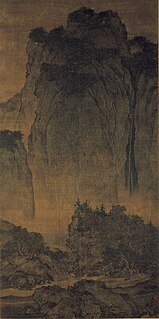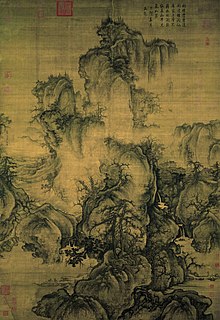 W
WCui Bai was a prominent Chinese painter of the Northern Song Dynasty (960–1279). A native of Anhui Province, Cui was best known for paintings of animals and plants. At some point during his life, he traveled to the capital of Kaifeng to seek employment as a court artist, and was accepted by Emperor Shenzong of Song, who admired his works. He became a renowned artist of Shenzong's court, but gained an awkward reputation for his often eccentric behavior.
 W
WFan Zhongzheng, courtesy name Zhongli, better known by his pseudonym Fan Kuan, was a Chinese landscape painter of the Song dynasty.
 W
WGuo Xi was a Chinese landscape painter from Henan Province who lived during the Northern Song dynasty. One text entitled "The Lofty Message of Forest and Streams" is attributed to him. The work covers a variety of themes centered on the appropriate way of painting a landscape. He was a court professional, a literatus, well-educated painter who developed an incredibly detailed system of idiomatic brushstrokes which became important for later painters. One of his most famous works is Early Spring, dated 1072. The work demonstrates his innovative techniques for producing multiple perspectives which he called "the angle of totality." This type of visual representation is also called "Floating Perspective", a technique which displaces the static eye of the viewer and highlights the differences between Chinese and Western modes of spatial representation.
 W
WHuang Tingjian was a Chinese calligrapher, painter, and poet of the Song dynasty. He is predominantly known as a calligrapher, and is also admired for his painting and poetry. He was one of the Four Masters of the Song Dynasty, and was a younger friend of Su Shi and influenced by his and his friends' practice of literati painting, calligraphy, and poetry.
 W
WLi Gonglin, style name Boshi (伯時), art name Longmian Jushi, was a Chinese antiquarian, painter, and politician during the Northern Song Dynasty.
 W
WLi Tang was a Chinese landscape painter who practised at Kaifeng and Hangzhou during the Song dynasty. He forms a link between earlier painters such as Guo Xi, Fan Kuan and Li Cheng and later artists such as Xia Gui and Ma Yuan. He perfected the technique of "axe-cut" brush-strokes.
 W
WMi Fu was a Chinese painter, poet, and calligrapher born in Taiyuan during the Song dynasty. He became known for his style of painting misty landscapes. This style would be deemed the "Mi Fu" style and involved the use of large wet dots of ink applied with a flat brush. His poetry was influenced by Li Bai and his calligraphy by Wang Xizhi.
 W
WSu Shi, courtesy name Zizhan, art name Dongpo, was a Chinese calligrapher, gastronome, painter, pharmacologist, poet, politician, and writer of the Song dynasty. A major personality of the Song era, Su was an important figure in Song Dynasty politics, aligning himself with Sima Guang and others, against the New Policy party led by Wang Anshi.
 W
WWang Shen, courtesy name Jinqing, was a Chinese calligrapher, painter, poet, and politician of the Song dynasty. He is best known for his surviving paintings, poetry, and calligraphy, and for his relationships with prominent statesmen and early amateur literati artists such as Su Shi, Huang Tingjian and Mi Fu.
 W
WWen Tong (1019–1079) was a Northern Song painter born in Sichuan famous for his ink bamboo paintings. He was one of the paragons of "scholar's painting", which idealised spontaneity and painting without financial reward.